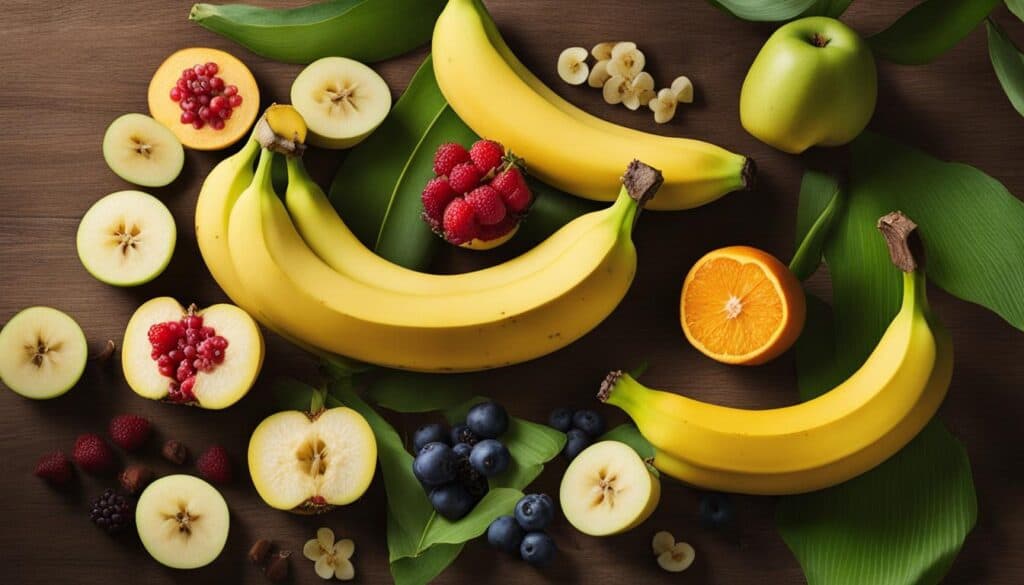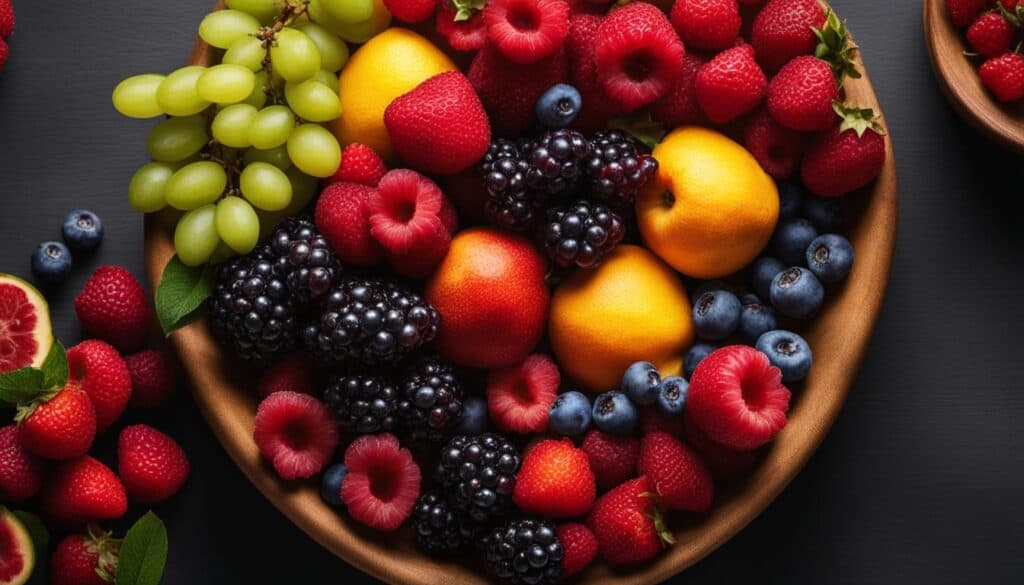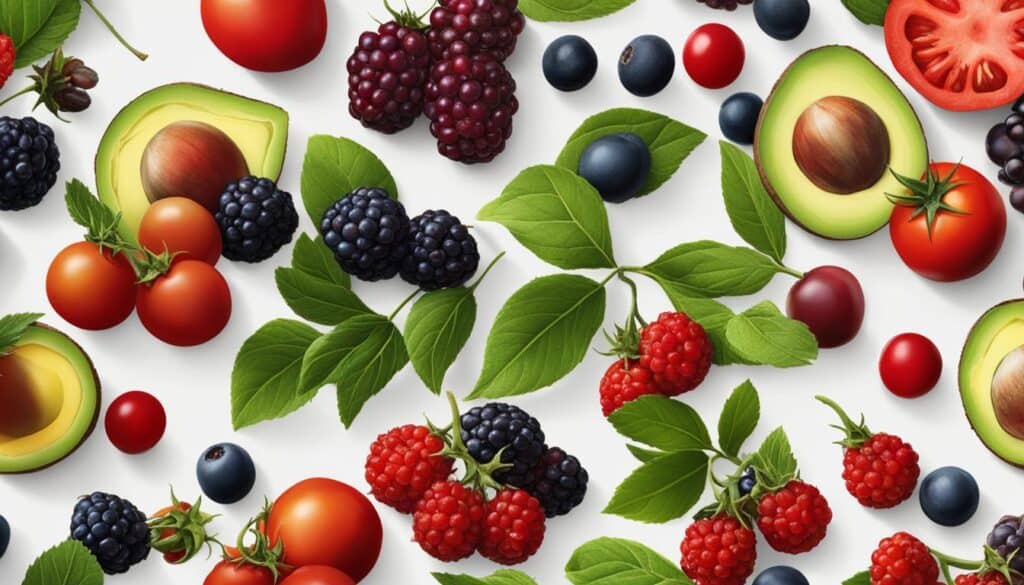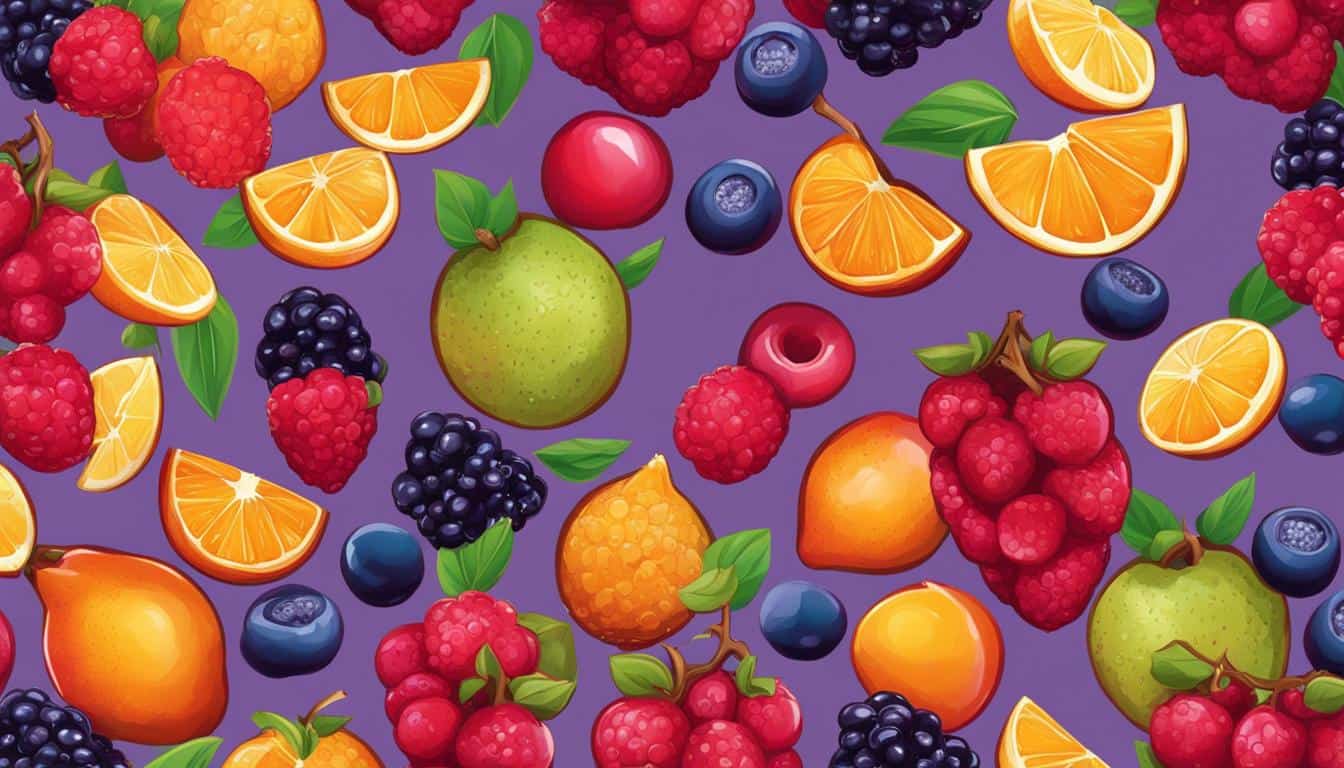Are all fruits considered berries? What sets berries apart from other fruits? In this article, we will explore the distinction between fruits and berries, specifically focusing on whether a banana can be classified as a fruit or a berry.
Key Takeaways
- Fruits are sweet, seed-holding structures of flowering plants, categorized as fleshy or dry.
- Berries are a subcategory of fleshy fruit.
- Despite being botanically classified as berries, bananas are not commonly thought of as such.
- Other surprising fruits that are berries include tomatoes, grapes, kiwis, avocados, peppers, eggplants, and guavas.
- Understanding the botanical requirements and characteristics helps clarify the distinction between fruits and berries.
What’s the Difference Between Fruits and Berries?
Fruits and berries are both delicious and nutritious, but they are not the same thing. Understanding the differences between fruits and berries can help you make informed choices when it comes to your diet. Let’s explore what sets these two categories apart.
When we talk about fruits, we are referring to the reproductive organs of flowering plants. Fruits can be classified into two main categories: fleshy fruits and dry fruits. Fleshy fruits, as the name suggests, have a soft and juicy texture. Examples of fleshy fruits include apples, oranges, and bananas. On the other hand, dry fruits are characterized by their hard and woody texture. Nuts, such as almonds and walnuts, are considered dry fruits.
Now, let’s delve into the world of berries. Berries are a subcategory of fleshy fruits. While all berries are fruits, not all fruits are berries. To be classified as a berry, a fruit must meet certain criteria. It must develop from a flower with one ovary, have a soft outer skin (exocarp), a juicy middle layer (mesocarp), and a soft inner layer (endocarp) that contains one or more seeds. Some examples of berries include strawberries, blueberries, and raspberries.
To summarize, fruits encompass a broader category that includes both fleshy and dry fruits. Berries, on the other hand, are a specific type of fleshy fruit that meet specific botanical criteria. Understanding these distinctions can help you better appreciate the diverse world of fruits and berries and make the most of their nutritional benefits.
| Fruits | Berries |
|---|---|
| Apples | Strawberries |
| Oranges | Blueberries |
| Bananas | Raspberries |
Bananas Are Botanically Berries
When it comes to the classification of fruits, bananas are an interesting case. Botanically speaking, bananas are actually classified as berries. This might come as a surprise to many, as bananas don’t fit the typical image of a berry. However, according to botanical criteria, bananas fulfill all the requirements to be considered botanical berries.
So, what exactly makes a fruit a berry? Botanical berries develop from a flower that contains a single ovary. They have a soft outer skin called the exocarp, a fleshy middle layer known as the mesocarp, and a soft inner layer called the endocarp that encloses multiple seeds. Bananas possess all of these characteristics, making them meet the botanical definition of a berry.
To further emphasize the classification, it’s worth noting that bananas share these characteristics with other fruits that are commonly accepted as berries, such as strawberries and blueberries. While bananas may not fit the stereotypical image of a berry, their botanical classification as berries is supported by their structure and development.

Nutrition Profile: Banana as a Fruit versus a Berry
From a nutritional standpoint, bananas provide a range of health benefits, regardless of their classification as a fruit or a berry. Bananas are rich in potassium, vitamin C, vitamin B6, and dietary fiber. They are also a good source of natural sugars, making them a quick and energizing snack option.
While bananas may not have the same antioxidant properties as some berries like blueberries or raspberries, they still offer numerous health benefits. The high potassium content in bananas supports heart health and regulates blood pressure. Additionally, the dietary fiber in bananas aids digestion and contributes to feelings of fullness, making it a great choice for those looking to maintain a healthy weight.
| Nutrient | Amount per 100g |
|---|---|
| Potassium | 358mg |
| Vitamin C | 8.7mg |
| Vitamin B6 | 0.4mg |
| Dietary Fiber | 2.6g |
Overall, whether you consider bananas as fruits or berries, it’s clear that they offer a variety of nutritional benefits. So, the next time you enjoy a delicious banana, you can appreciate it for being botanically classified as a berry while still providing essential nutrients for your well-being.
Fruit versus Berry: Choosing Between the Two
When it comes to the distinction between fruits and berries, things can get a bit confusing. While botanically speaking, bananas are considered berries, they are not commonly thought of as such. This discrepancy stems from the historical use of the term “berry” before the precise botanical classification was established. Many fruits, including bananas, do not have “berry” in their name and are not typically considered berries. This lack of awareness about the specific classification adds to the confusion.
However, it’s important to note that while bananas may not be recognized as berries in everyday language, they still fall under the category of fruit. So, if you’re trying to choose between fruit and berry, rest assured knowing that bananas and other similar fruits can be enjoyed as part of a healthy diet.
To better understand the concept, let’s take a look at a breakdown:
| Fruit | Berry |
|---|---|
| Reproductive organ of a flowering plant | Subcategory of fleshy fruit |
| Can be fleshy or dry | Characterized by a soft exocarp, fleshy mesocarp, and soft endocarp enclosing one or more seeds |
| Includes a wide range of fruits like apples, cherries, and bananas | Includes fruits like bananas, tomatoes, and grapes |
As you can see, while the classification may differ, both fruits and berries offer their own unique benefits and are delicious additions to a well-rounded diet. So, whether you’re enjoying a sweet banana or savoring a juicy berry, you can’t go wrong with incorporating these nutrient-rich delights into your daily meals.
Other Surprising Fruits That Are Also Berries
While bananas may be the most well-known example of a fruit that is also classified as a berry, they are not the only ones. There are several other fruits that fall into this category, offering a delightful surprise to those who discover their botanical classification. Some of these surprising fruits that are also berries include:
- Tomatoes: Yes, tomatoes are technically fruits, and they are also classified as berries. Despite being commonly mistaken as a vegetable, tomatoes are fleshy fruits that develop from the ovary of a flower.
- Grapes: Grapes, whether in their juicy red or sweet green form, are also considered berries. These small, succulent fruits grow in clusters and possess all the necessary characteristics of a botanical berry.
- Kiwis: Known for their vibrant green flesh and tangy flavor, kiwis are another surprising fruit that is classified as a berry. They meet all the criteria of a botanical berry, including their characteristic fleshy middle and multiple seeds.
- Avocados: Avocados, often associated with savory dishes and guacamole, are technically berries. Their creamy texture and unique flavor make them a versatile addition to both sweet and savory recipes.
These fruits may not immediately come to mind when thinking of berries, but their botanical classification as berries highlights the diversity and complexity of the fruit world. Each of these fruits offers its own unique taste, texture, and health benefits.
Speaking of health benefits, one of the advantages of consuming fruits and berries is their rich nutritional profile. They are packed with essential vitamins, minerals, and antioxidants that support overall health and well-being. Incorporating a variety of fruits and berries into your diet can provide a range of benefits, such as boosting immune function, promoting heart health, and contributing to healthy digestion.
| Fruit | Nutritional Benefits |
|---|---|
| Tomatoes | High in lycopene, a powerful antioxidant that may help reduce the risk of certain cancers |
| Grapes | Contain resveratrol, which has been linked to various health benefits, including improved heart health |
| Kiwis | Excellent source of vitamin C, vitamin K, and dietary fiber, which can support immune function and digestion |
| Avocados | Rich in healthy monounsaturated fats, which may help lower LDL cholesterol levels |
So, the next time you enjoy a juicy tomato, a bunch of grapes, a refreshing kiwi, or a creamy avocado, remember that you’re not just indulging in a delicious treat – you’re also savoring a surprising botanical berry!
The Bottom Line
Berries are a subcategory of fruit, representing the sweet, fleshy, seed-holding structures of flowering plants. Bananas, fulfilling the botanical requirements of a berry, can be considered both a fruit and a berry. The distinction between fruits and berries may be complex, but understanding the specific botanical classification helps clarify the differences.
To summarize, fruit is the general term encompassing all sweet, seed-bearing structures of flowering plants. This category includes fleshy fruits like apples, cherries, and bananas, as well as dry fruits like nuts and legumes. Berries, on the other hand, are a specific type of fleshy fruit characterized by their soft exocarp, fleshy mesocarp, and soft endocarp enclosing one or more seeds.
| Category | Definition | Examples |
|---|---|---|
| Fruit | Sweet, seed-holding structures of flowering plants | Apples, cherries, bananas |
| Berry | Subcategory of fruit with specific characteristics | Strawberries, blueberries, bananas |
While bananas are botanically classified as berries, they are not commonly thought of as such due to historical usage and lack of awareness about the specific botanical classification. Similarly, other fruits like tomatoes, grapes, kiwis, avocados, peppers, eggplants, and guavas qualify as botanical berries but are rarely recognized as such. Understanding the botanical requirements and characteristics of fruits and berries helps shed light on their true nature and dispel confusion.

Now that we’ve clarified the fruit and berry distinction, let’s delve deeper into what defines a fruit and explore the various types of fleshy fruits in the next section.
What Makes a Fruit a Fruit?
When it comes to understanding the classification of fruits, it’s essential to consider their definition and characteristics. Fruits are the reproductive organs of flowering plants, responsible for seed distribution. They can be categorized into two main types – fleshy and dry fruits. Fleshy fruits are what we commonly associate with the term “fruit” and include a variety of types such as simple, aggregate, and multiple fruits.
Fleshy fruits are characterized by their soft and juicy texture, often containing seeds. Examples of fleshy fruits include apples, oranges, and berries. These fruits develop from the flower’s ovary and are typically consumed as a delicious and nutritious snack. On the other hand, dry fruits, such as nuts and legumes, have tough outer coverings and do not have the same fleshy composition as their counterparts.
To better understand the classification of fruits, let’s take a look at a table that highlights the different categories of fruits and their characteristics:
| Type of Fruit | Characteristics |
|---|---|
| Simple Fruit | Develops from a single ovary, examples include apples and oranges |
| Aggregate Fruit | Develops from several ovaries in a single flower, examples include raspberries and strawberries |
| Multiple Fruit | Develops from multiple flowers in an inflorescence, examples include pineapples and figs |
By understanding the classification and characteristics of fruits, we can appreciate the diverse nature of these delicious and nutritious plant products. Whether it’s a simple fruit like an apple or an aggregate fruit like a strawberry, each type brings its unique qualities to the table.
What Makes a Berry a Fruit?
Berries are a subcategory of fleshy fruit that possess specific characteristics distinguishing them from other types of fruits. To understand what makes a berry a fruit, we need to examine the botanical requirements and physical attributes associated with this category. Berries develop from flowers containing a single ovary and typically have a soft exocarp, fleshy mesocarp, and a soft endocarp enclosing one or more seeds.
Unlike other fruits, berries have a unique combination of characteristics that make them easily identifiable. The soft exocarp gives them a pliable outer skin, while the fleshy mesocarp provides a juicy and sweet middle. These traits, along with the presence of multiple seeds, are what set berries apart from other fleshy fruits.
To further illustrate the distinction between berries and other fleshy fruits, here is a table comparing their characteristics:
| Characteristic | Berries | Other Fleshy Fruits |
|---|---|---|
| Development from a flower with one ovary | ✓ | ✗ |
| Soft exocarp | ✓ | ✗ |
| Fleshy mesocarp | ✓ | ✗ |
| Soft endocarp enclosing one or more seeds | ✓ | ✗ |
As shown in the table, berries possess all of the unique characteristics associated with their classification, including development from a single-ovary flower, a soft exocarp, a fleshy mesocarp, and a soft endocarp enclosing seeds. These features differentiate berries from other fleshy fruits, such as apples or cherries, which lack one or more of these defining characteristics.
Other Surprising “Berries” and Their Characteristics
While bananas may be the most well-known surprising botanical berries, there are several other fruits that fall into this category. These fruits possess similar characteristics and development patterns, making them scientifically classified as berries, despite not being commonly recognized as such. Some of these surprising “berries” include tomatoes, peppers, cranberries, eggplants, and kiwis.
Tomatoes, often mistaken for vegetables, are actually botanical berries. They develop from flowers with a single ovary and have soft exocarps, fleshy mesocarps, and juicy endocarps enclosing numerous seeds. Similarly, peppers, both sweet and hot varieties, exhibit the same berry characteristics. They are formed from flowers with one ovary and have the characteristic soft texture and multiple seeds.
“Tomatoes and peppers are often mistaken for vegetables, but they are actually botanical berries. Their classification as berries showcases the diversity of these sweet, fleshy fruits.”
Cranberries, known for their tart flavor and vibrant red color, are also classified as botanical berries. They develop from flowers with one ovary and display the characteristic fleshy middle and enclosed seeds. Eggplants, with their deep purple skin and mild flavor, share the same botanical classification. Kiwis, with their fuzzy brown exterior and juicy green flesh, are yet another example of surprising botanical berries.
These “berries” may not fit the traditional image of berries, but their botanical classification as such highlights the diversity and complexity of fruit categorization. Understanding the specific characteristics and development patterns can provide a fascinating insight into the world of fruits and berries.

Conclusion
The classification of fruit and berries can be complex, often leading to confusion. Understanding the botanical requirements and characteristics helps clarify the distinction. While fruits can be divided into various categories, berries are a specific subcategory of fleshy fruit. Bananas, along with other surprising fruits, fulfill the requirements for botanical berries.
Whether a banana is a fruit or a berry depends on the specific botanical classification. While bananas are botanically considered berries, they are not commonly thought of as such. This discrepancy arises from the historical use of the term “berry” before the precise botanical classification was established. Many fruits, including bananas, do not have “berry” in their name and are not typically recognized as berries.
Nevertheless, bananas meet all the requirements to be classified as botanical berries. They develop from a flower containing one ovary and have the necessary structures like the exocarp, mesocarp, and endocarp. Additionally, other surprising fruits like tomatoes, peppers, cranberries, and kiwis also qualify as botanical berries, despite not being commonly acknowledged as such.
FAQ
What is the difference between a fruit and a berry?
Fruits are the sweet, seed-holding structures of a flowering plant, categorized as fleshy or dry. Berries are a subcategory of fleshy fruit.
Are bananas considered berries?
Yes, bananas are classified as berries based on their botanical characteristics.
Why are bananas not commonly thought of as berries?
The confusion arises from the historical use of the term “berry” before the precise botanical classification was established. Many fruits, including bananas, are not typically considered berries.
What other fruits are classified as berries?
Other fruits classified as berries include tomatoes, grapes, kiwis, avocados, peppers, eggplants, and guavas.
Can a fruit be considered a berry?
Yes, a fruit can be considered a berry if it meets the specific botanical requirements for classification.
How is the distinction between fruits and berries clarified?
Understanding the specific botanical classification, including the development of the fruit from a flower containing one ovary and the presence of specific structures, helps clarify the distinction between fruits and berries.
Do berries count as fruit?
Yes, berries are a subcategory of fruit. All berries are fruits, but not all fruits are berries.
What defines a fruit?
Fruits are the sweet, fleshy, seed-holding structures of a flowering plant, responsible for seed distribution.
What defines a berry?
Berries are a subcategory of simple fleshy fruit, developing from a flower with one ovary and having specific characteristics like a soft exocarp, fleshy mesocarp, and soft endocarp enclosing one or more seeds.
Are there other surprising “berries” that are not commonly recognized as such?
Yes, several fruits like tomatoes, peppers, cranberries, eggplants, and kiwis are botanically classified as berries but are rarely recognized as such.





Leave a Reply